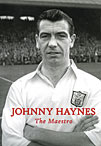 The Maestro
The Maestro
by Martin Plumb
Ashwater, £27.50
Reviewed by Neil Hurden
From WSC 258 August 2008
You could rely on one thing at Craven Cottage in the 1970s. At moments of maximum desperation in the Fulham ranks, one of the denizens of the strange, non-Leagueish world of the Stevenage Road Enclosure would inevitably pipe up with the ironic refrain: “Bring on Johnny Haynes!”
For those of us brought up on more prosaic talents, the presence of one of the greats on the banks of the Thames only a decade or so earlier was far more symbol than reality. The lack of television coverage, especially for lowly Fulham, has always meant that a true appreciation of the man’s genius has been elusive. Being named by countless players and journalists of a certain age as the greatest ever passer of the ball in the English game gives a flavour, as do the statistics: 56 games for England (22 as captain), with 18 goals, before injury cut short his international career at the age of only 27.
Filling a good part of the void, though, we now have this lovingly compiled record of Haynes’s life and career. Featuring the photographs of Ken Coton, official recorder of the club’s fortunes for many years, Martin Plumb’s work brings out far more of the man behind the grainy legend than ever before. Charted in intricately researched detail, they provide a revealing picture not just of Haynes himself but also late Fifties/early Sixties society in all its glory: sharp suits; a surfeit of Brylcreem; mud-laden pitches; garish cigarette cards; and, of course (being Fulham), unusual directors.
As well as epic events, such as Haynes’s magisterial performance in England’s 9‑3 victory over Scotland in 1961, and the two classic but inevitably disappointing FA Cup semi-final replay defeats in 1958 and 1962 – my father still mutters darkly about both – there is the quirky and sad, too. The 15-year-old Haynes, north London born, only choosing Fulham because a friend, Tosh Chamberlain, had recently signed, was subsequently deviously bound to the club by the offer of a job as office boy. Poignantly, too, a picture of Haynes with England Under-23 team-mates Duncan Edwards and David Pegg, about to get on a plane, which was apparently later shot at by a MiG fighter near Bucharest.
The subtext of the book asks why a man who would have walked into an all-time England team as the midfield playmaker is not known in quite the same breath as Charlton, Moore, Matthews and Finney. Playing half his career in Division Two was clearly part of it; perhaps the later move to Durban City had an impact, too. Certainly the sight of Haynes and a “British All Stars” team lining up to play whites-only football in South Africa in 1973 is not an endearing one. Significantly, there is no glossing over of this aspect of Haynes’s late career, which was criticised by, among others, his old friend Bobby Robson. Overall, the authors deserve great credit for bringing the footballer and the man closer to generations of younger Fulham fans. It’s still galling to have missed out on the real thing, though.